One of the most interesting themes that recurs within the investment world is the waxing and waning of corporations based upon how each company’s management responds to technological change and/or changes within customer preferences or expectations. Let’s consider two well-chronicled examples of this phenomenon:
1) Sears (SHLD) versus Walmart (WMT):
a. Sears Roebuck began in the 1880’s and revolutionized U.S. merchandizing – first through its national catalogue operations, and then through creating the world’s largest retail operation (highlighted by “big box” stores within prime metropolitan shopping center locations).
i. Sears’ “peak” was symbolized when it built and occupied a Chicago skyscraper that dwarfs the city – in 1973. (“Sears Tower”… now “Willis Tower”).
ii. During its history, Sears created and grew such iconic brands as Kenmore, Craftsman, and DieHard.
iii. It also created, ran, and later spun off Allstate Insurance and Discover Card (among others).
b. Walmart was started in July, 1962, when Sam Walton opened his first Wal-Mart store in Arkansas.
i. By 1967, he had 24 stores.
ii. He didn’t incorporate Wal-Mart until 1969…. And he took the stock public in 1970.
iii. WMT reached $1 billion in annual sales in 1980 – the fastest any retailer had (until then) achieved that milestone.
iv. During the 1980’s, it opened its first Sam’s Club store and its first Walmart Supercenter.
v. By 1990, WMT had become the biggest retailer in the U.S.
vi. Through the 1990’s and well into the first decade of the 21st Century, WMT was regularly used as a “Case Study” within MBA classes on such topics as:
c. Corporate Focus: “Every Day Low Prices”
d. Supply Chain Management: Unprecedented Efficiency through state of the art technology…. including the use of RFID technology for over 10 years.
e. Cost Management: from vendors to labor, WMT pressured its “partners” on price.
Those final lines within the WMT story highlight one of the chief competitive advantages that catapulted WMT far beyond SHLD within retailing – namely, Sears had an old, outdated infrastructure that served both the customer and company well in “its day”, but became a costly barrier to competition during a time of major technological and demographic change. In sharp contrast, Sam Walton built WMT (from the ground up) based on availing himself of every technological advantage he could muster.
Obviously, there was much more at work during this “sea change” within U.S. retailing; however, most analysts agree that WMT won the “retail war” by harnessing technology, while SHLD was restrained by its massive, relatively outdated infrastructure.[1]
2) Apple Inc’s (AAPL) i-Phone (IOS) versus all iterations of Google Inc’s (GOOG) Android operating system.
a. It is widely accepted that AAPL’s i-Phone started the “mobile smartphone” revolution… blowing away the market with its design, functionality, ease of use, etc. In the process, it set “market expectations” for future phones and made the “iPhone” a status symbol (especially in the school setting — where peer pressure is especially strong).
i. As was its prerogative, AAPL management chose to keep the details of the system “locked down” – maintaining control of how IOS phones are designed, manufactured, and marketed.
ii. It also maintained management of IOS phone app developers.
iii. Those strategies enabled AAPL to continue its practice of managing (and maximizing) profit margin!
iv. In the iPhone’s early years, that benefited the company’s bottom line.
b. In contrast, GOOG started in the position of playing “catch up” in the smartphone market. However, it made a radically different choice regarding the management of its technology/branding.
i. GOOG made the Android technology more accessible and available.
ii. That strategic choice is reflected in the almost endless list of Android phone models that have come to market… manufactured by well over 12 manufacturers (I ran out of patience before the list ran out of makers).
iii. It is guaranteed that (on average) Android phones do not have nearly the profit margin that i-Phones do… however, it is fair to say that Android has attained a commanding lead in smartphone market share.
c. Consider this data from the International Data Corporation (IDC) at the end of Q3 of 2013:

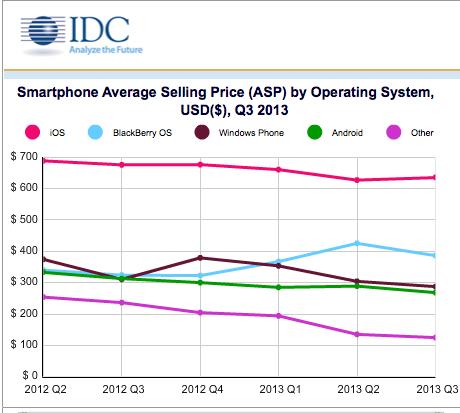 iv. There is no question regarding WHY Android is gaining share in this magnitude. One chart tells the story. As you can see, the price of Android phones is kept very attuned to the market’s willingness to spend.
iv. There is no question regarding WHY Android is gaining share in this magnitude. One chart tells the story. As you can see, the price of Android phones is kept very attuned to the market’s willingness to spend.
This theme of “waxing and waning” intrigued me enough to spend a great deal of time thinking through what business and investment lessons can be gleaned from these issues. I will not pretend to have identified all such possible lessons, but here are a few that definitely rate study and reflection:
1) If you are part of the management of an existing company, it is essential to be laser-committed to doing the following:
a. Never lose sight of your corporate vision and strategy.
i. Keep everyone focused on the key elements (and metrics that measure them) of that vision and strategy.
ii. As you proceed through annual monitoring (below) and reassessment, be willing to adjust that vision and strategy as appropriate (necessary).
b. Allocate limited corporate resources in ways that will maximize the achievement of corporate vision and strategy.
c. Monitor your target market with a totally open mind, so you accurately track real conditions and recognize current and projected trends;
d. Have staff (or trusted consultants) whose responsibility is to stay abreast of IT developments/tools/applications that hold a potential for increasing efficiency at a reasonable price.
e. Most important: don’t believe positive press reviews … especially if the business press is practically unanimous in lauding management decisions. (Soon enough, they will suggest you don’t know what you are doing).
i. And NEVER EVER, EVER assume that you have “arrived” as an executive/manager and have your business “all figured out”!!
2) If you are an entrepreneur, stay alert to changes/trends within your markets of greatest interest.
a. When some change or dislocation develops (prompted by evolving technology or consumer shifts), evaluate what sort of opportunity might exist.
b. If it appears an opportunity does exist, assess (preferably with other competent persons) the parameters of that opportunity – with a particular eye to the size of the potential market and the resources needed to offer a product/service that addresses that opportunity.
c. Once you decide to proceed, secure agreement with your partners regarding the objectives you will target in your business and a preliminary “end game” for your business.[2]
d. In any event, steel yourself for an adventure, with ups and downs. That will help prepare you for the inevitable times of discouragement, as well as empower you to work through them.
3) As an INVESTOR:
a. Never confuse your personal attachment to, or distaste for, any given product as a “buy” or “sell” signal for the stock of that company that produces it.[3]
b. Never accept at face value what a company’s management team says or writes about that company.
i. A company shareholder report is (alas) too often 9 parts “spin” and 1 part “fact”.
ii. The only section of the Annual Report for which anyone is truly held accountable is the annual financial report, which (by law) must be signed by the CEO and the CFO.
c. The reality is that fewer have been caught and held accountable for misstatements and/or fraud than have knowingly (or unknowingly) inserted falsehoods into a report!
iii. Let me amplify what I have written in ii) above.
e. To be diplomatic, I have just wrapped up days of trying to reconcile what I have read about some key issues surrounding a firm with what I could find (or couldn’t find) in its most recent six annual reports.
iv. As we have warned in several past articles, investment analysts are not beyond suspicion, as well.
f. The bias among wire house analysts is to tout stocks, since that leads to “buys”, which leads to higher revenue for their employer (“Buy side” analysts).
g. Analysts with investment banks are particularly suspect, especially when the bank is part of a team managing an IPO, a consult on strategic alternatives, or a new issue of debt.
So, let’s consider an example of what I term the “Waxing and Waning” phenomenon within business. Turning our back on the easy, over diagnosed contrast between “brick and mortar” retailers versus E-tailers (EBay (EBAY); Amazon (AMZN)), let’s consider a business segment that gets lots of attention at the close of one year and the start of another: Business Solutions/Accounting/Tax Records and Filing.
 Within that sphere… the first name that pops into my head is INTUIT (INTU). INTU was started some thirty years ago, when I was still preparing my annual income tax return by hand with pen and ink.[4] Meanwhile, double entry bookkeeping and fund accounting were beyond the ken of the average small business person (much less consumer).
Within that sphere… the first name that pops into my head is INTUIT (INTU). INTU was started some thirty years ago, when I was still preparing my annual income tax return by hand with pen and ink.[4] Meanwhile, double entry bookkeeping and fund accounting were beyond the ken of the average small business person (much less consumer).
In the midst of a technological void (in 1983) within financial/accounting services, a company emerged with a vision regarding to “fill” that void! The company’s name was INTUIT (INTU). Its technology was so disruptive (and/or its marketing so successful) that it soon enough surpassed (and eliminated) as many as 46 competitors. That successful foray into taxpayer and small business services made household names of TURBO TAX, QUICKEN, and QUICKBOOKS.
As a result of INTU’s thirty years of dominance, Quickbooks has been (for years) the world’s largest provider of accounting software for small business, and Turbo Tax has been considered the biggest competitor to the iconic U.S. tax “brand”: H&R Block (HRB).
Some mostly forgotten “history” is worth noting at this point. INTU was not an overwhelming success until the introduction by Microsoft (MSFT) of Windows 3.0 (in the early 1990’s). Seeing the success of Quicken… MSFT developed a competitor – Microsoft Money. To counter the ever-heavy hand of MSFT, INTU innovated a $15 Rebate Program – providing retailers with a coupon through which consumers could secure that $15 (the first such marketing scheme to come from a software firm)! Not surprisingly, MSFT tried to buyout INTU by 1994 – at which point it had reached a market capitalization of $2 billion. That buyout attempt was nipped in the bud by the U.S. Department of Justice.
When he founded INTU, Scott Cook’s vision was that the personal computer was going to revolutionize personal, small business, and tax accounting. As we suggested earlier, he was clear on the market need he was addressing, the customers he was targeting, and resources he needed (most significantly, a great programmer, whom he found in Tom Prouix of Stanford.
The marketing plan for Quicken and Turbo Tax was focused on the average consumer – who could benefit from organizing personal finances (checkbooks, savings, investments, etc.) and income tax filing within the vastly superior setting of a computer! However, for Quickbooks, the plan became focused upon professional accountants, with the intention that the accountants would use Quickbooks as a “feeder system” from its small business clients into the accounting firm’s server, thereby reducing financial data gathering time and expense and freeing the accounting firm to serve more clients… and/or to expand the range of services offered to businesses. [Keep that vision in mind for later!]
Notwithstanding all of the success INTU has achieved, its reputation has not gone unsullied through these several decades:
1) In 1997, it shared in the development of a proprietary code format (QFX) for the download of financial information from banks, brokers, etc. This was not a “solution” to a “how to download” problem, because a tested and proven code (QIF) had been handling that for years. When INTU phased out support for QIF and maintained support only for QFX – it did so for one reason alone. Use of QFX required a licensing fee be paid to INTU, while QIF was free (today, we call that “monetizing”);
2) In 2007, INTU negotiated a deal with the IRS that secured the government’s promise that it would not set up its own Web portal for (free) e-filing.
3) In 2009, INTU expended almost $2 million in contributions to motivate California lawmakers to eliminate free online filing of state income tax by low-income residents in that state.
Today, Intuit Inc. (INTU) is a California-based vendor of business and financial management solutions for small businesses, consumers, accounting professionals, and financial institutions. Its largest customer base is in the U.S., but it also serves clients in Canada, Great Britain, India, and Singapore… with a much smaller presence in several minor markets (for example: Australia). The company employs over 8,000 persons. Since MSFT’s buyout bid in 1994, it has grown its market capitalization up by a factor of 10 – to approximately $20 billion.
The company's products and services are divided into seven business segments – which include: financial management solutions (17 percent); employee management solutions (12 percent); payment solutions (10 Percent); consumer tax (35 percent); accounting professionals (10 percent); and financial services (9 percent).
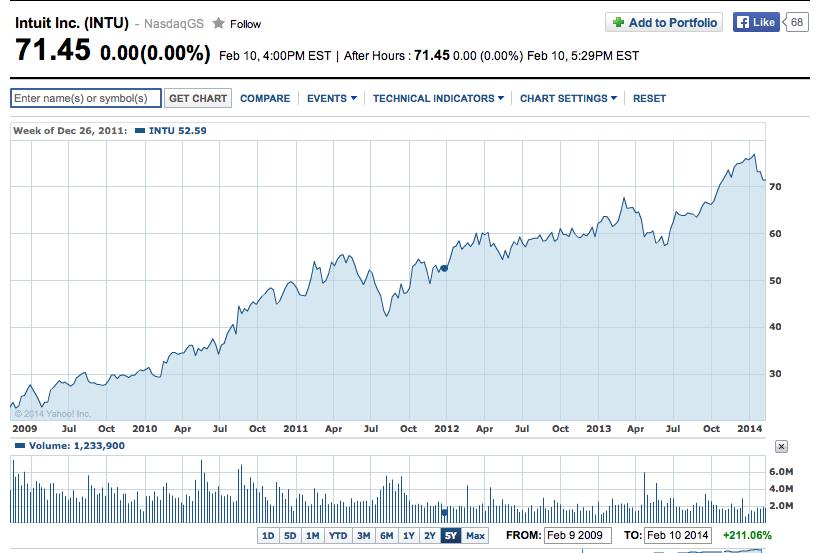 In addition to millions of customers, we can see from the five-year chart below that INTU has a solid demand among investors on Wall Street:
In addition to millions of customers, we can see from the five-year chart below that INTU has a solid demand among investors on Wall Street:
So here we have a solid, established company that successfully rose from humble beginnings to dominate its market through focus and diligence. Does it face any challenges that might threaten its continuing dominance?
Interestingly, I discovered that my best source for information on the “challenges” INTU faces came from resources INTU itself prepared and published!
Consider this chart (to the right) of the projected trends within the “business/ financial/tax services” space between now and the year 2020.
Just as the IT world has made a dramatic shift toward “mobile” and the “cutting-edge” of retailing is currently found within the e-commerce space, so to is INTU’s industry becoming transformed at an accelerating space. The focus can no longer be upon a “boxed” software product waiting at a Best Buy or a Staples store for a prospective customer to see and buy. Instead, the industry has shifted toward “Software as a Service” (SaaS)[5]… within which an “Application Service Provider” (ASP) provides the desired program (and its related services) via the (ubiquitous) “Cloud”.
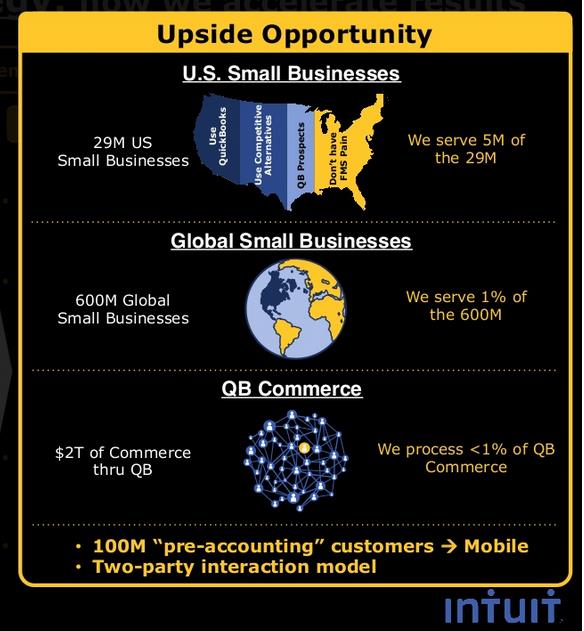 Looking at the industry as a whole, the metrics suggest a potentially immense potential for growth within the United States and the world. Take a moment to review the chart to the right:
Looking at the industry as a whole, the metrics suggest a potentially immense potential for growth within the United States and the world. Take a moment to review the chart to the right:
As you see the chart suggests, the scale of “potential” new customers for an ASP within this space is (at least):
1) 24 million small businesses in the U.S. alone;
2) 99% of the 600 million small businesses around the world;
3) Almost $2 trillion in global commerce that currently gets “run through” Quickbooks for which INTU provides no processing and secures no fees.
At this point, you may have noticed that I worded this market “potential” in a generic way, without reference to it being INTU’s “potential market”. I worded it this way because the market is in the midst of an extraordinarily transformative period. In this period of technological innovation, even INTU concedes that this huge market is in no way “locked up” by them!
Let’s recall the day (not long ago) when it appeared that AAPL had the smartphone market “locked up”. Everybody wanted one! That day is long gone.
Consider these “risks” identified by INTU (as required by the SEC) within a recent 10-K filing (all highlighting with bold font is attributable to the author):
“We face intense competitive pressures that may harm our operating results.
“Our competitors and potential competitors range from large and established entities to emerging start-ups. Our competitors may introduce superior products and services, reduce prices, have greater technical, marketing and other resources, have greater name recognition, have larger installed bases of customers, have well-established relationships with our current and potential customers, advertise aggressively or beat us to market with new products and services….
“We also face intensified competition from providers of free accounting, tax, payments, and other financial services. In order to compete, we have also introduced free offerings in several categories, but we may not be able to attract customers or effectively monetize all of these offerings, and customers who have formerly paid for Intuit’s products and services may elect to use free offerings instead.”
Even within the U.S. tax preparation space (largely fought between INTU and HRB) INTU will face increased pressure moving forward. That competition was bad enough in FY 2013, causing INTU to “disappoint” Wall Street on April 25th regarding its report of tax returns prepared. Note the 11% decline in just one day:
This competitive pressure will keep building, with some considerable uncertainty lying ahead due to the expiration of the “Free File Alliance” agreement this coming October. Here is what INTU writes about these pressures:
“Our consumer tax business also faces significant competition from the public sector, where we face the risk of federal and state taxing authorities developing software or other systems to facilitate tax return preparation and electronic filing at no charge to taxpayers. These or similar programs may be introduced or expanded in the future, which may cause us to lose customers and revenue. Although the Free File Alliance has kept the federal government from being a direct competitor to Intuit’s tax offerings, it has fostered additional online competition and may cause us to lose significant revenue opportunities. The current agreement with the Free File Alliance is scheduled to expire in October 2014.”
If you doubt this will cause INTU issues looking ahead, just “Google” a phrase such as “free tax return filing” or “how to file your tax return cheaply”. The competition is fierce, and it will only continue to grow.
How has INTU been responding to these challenges? I’ve spent a good deal of time during the past couple of weeks unearthing as much information as I can.
The most interesting corporate strategy I have discovered is an ambitious, continuous “Stock Buyback” program! Since the start of FY 2010, INTU has repurchased at least $3.5 billion of its common stock.
You might think: “That’s great!” They are shareholder-friendly!” You might feel that thought is reinforced by the fact that a dividend was instituted in FY 2012… and is now up to $0.19/share each quarter.
However, consider these thoughts:
1) Most experts agree (especially Warren Buffett) that a stock buyback makes sense only when the company’s shares are excessively undervalued, or management has absolutely no more profitable option through which to employ excess cash;
2) Experts also caution (in light of the above) that, in the current environment, a number of management teams have employed share buybacks as the quickest (and easiest) way to raise the most watched “per share” metrics related to their company (especially Earnings/Share);
3) The management and board of INTU initiated an ambitious “Stock Buyback” program on November 19th of 2009. Since then, they have authorized additional buybacks.
a. The result has been that since a $900 million billion share repurchase during FY 2010, INTU has repurchased approximately $3.5 billion of common stock.
b. The company currently has a “open” authorization to repurchase $1.4 billion in additional shares (as of the end of FY 2013).
c. Consider that these repurchases (through the end of FY 2013) equal 4.41 times the total GAAP Net Income from FY 2012.
d. These repurchases (in total) also represent almost 160% of Stockholders’ Equity as of October 31, 2013 (see the financial table in the Appendix).
4) The repurchases began when INTU stock was priced near $35.
a. At present, repurchases are being done with the price at twice that level.
5) Finally, one INTU commentator notes that, since the buybacks began, INTU “insiders” (per the SEC definition of the term) have sold at least $4 billion of common shares.
a. They purchased options and/or exercised options, while selling more stock than has been repurchased.
I must hasten to insert the crucial caveat that none of the above, in and of itself, is grounds for undue concern. However, Warren Buffett would point out a couple of self-evident points:
1) Ideally, an investor should prefer to invest in a company whose shares are being snapped up by members of management (and other insiders) because they are confident of the future.
2) It is management’s responsibility to find the most profitable use for excess cash – which (unless shares are way undervalued) is likely to be something other than a share buyback.
We’ve already referred to heated competition within the U.S. tax preparation space. An even bigger challenge facing INTU is the expanding competition within the small business accounting/services space. I suspect that this may be the arena within which INTU is most vulnerable.
Consider these observations from Michael Block, a Florida-based CPA who (for a number of years) has been a member of one of the groups of CPAs upon which INTU relied for feedback and ideas regarding the Quickbooks product line. Mr. Block posts on the Internet quite often through Linkedin and his blog (http://1234567890.typepad.com/quickbooks/2013/10/xero-intuit-war-exploding.html). There is no question that he has a wide range of experience within the space, with the additional advantage of having connections within the national CPA community, at Quickbooks itself, and within a new, emerging international competitor![6] Within the past nine months, Block has reported the following:
a) The former head of the INTU program focused upon nurturing a partnership with CPAs (the Quickbooks ProAdvisor program) has been hired for a similar role by the primary international competitor!
b) In a cost-cutting effort, INTU cut one third of its U.S.-based ProAdvisor support staff, thereby being directly responsible for CPAs (needing program support) spending much longer periods of time on “hold” – often ending up with a support person overseas, lacking accounting training and relying strictly upon “help databases” as the primary means through which to assist customers;
c) Quickbooks “desktop” has lost 17% of its users, and Quickbooks “add-ons” have lost 70% of Google weblinks during the past 24 months.
d) Quickbooks insiders had been requesting a “workflow” product (linking Quickbooks and INTU tax products) for an extended period of time.
a. Insiders saw no progress on that request until the overseas competitor purchased, vastly improved, and then made available to professional users (at no cost) a workflow product.
b. Suddenly (according to an INTU employee) this motivated INTU to purchase an existing workflow product (a product that had been previously available in the market at no cost).
i. The company that produced said product had been “up” on a website for all of six months and 13 days before INTU purchased the product.
ii. INTU repackaged the product and now makes it available for $99 a month.
e) In a situation that parallels the fragile relationship a few years ago between Fidelity, Vanguard, and TD Ameritrade and financial advisors (when the fund companies started offering advice and managed portfolios)… INTU reached out directly to the average consumer to expand its market for Quickbooks.
a. Widely distributed INTU ads touted the premise that users did not need bookkeepers or accountants to maintain their financial records, as long as they used Quickbooks.
b. That attitude still sours the opinion of countless CPAs toward INTU.
f) INTU’s chief international competitor scheduled a big user conference/education event in San Francisco, an event which hundreds of formerly faithful Quickbooks users attended, despite INTU (at the last minute) scheduling four competing events in the same time frame and initiating a series of personal phone calls to users that urged them not to attend that competitor event.
In case these anecdotes above don’t cause you any concern about INTU, consider this posted statement from Mr. Block: “Personally, I would still rather spend an hour at the dentist than an hour using Quickbooks Online!”
INVESTOR TAKEAWAY: I am not suggesting that INTU is a doomed company or a washed up stock. Far from it! In fact, if you look at “the numbers” for INTU and read the commentary from its management team, you will likely be impressed.
I personally would liken the INTU circumstance to the stance of Sears in the 1980’s – “King of the Hill” within its space, but facing steadily increasing pressure from a rapidly growing competitor. In times of technological and social/economic change, it is (in my opinion) a real advantage to be an underdog – highly motivated, equipped with a more contemporary infrastructure, and not burdened by a huge existing user-base that resists “change”.
In terms of technological flexibility and “open structure”, I would liken INTU more to the AAPL iPhone (IOS) than to the Google Android operating system. INTU’s “core” structure started its evolution in the mid 1980’s… which currently proves to be a blessing and a curse: a) Blessing because it is “proven” and it has a huge existing base; b) Curse because it is older and more difficult to change, on several levels.
In addition, of course, the total corporate infrastructure of INTU is bigger and more expensive. Younger, more hungry and “nimble” companies, will always have a number of natural advantages during periods of transition.
Finally, as I have researched, studied, and contemplated the data that I have unearthed on INTU, I feel an essential “disconnect”. Something does not feel right. But I cannot authoritatively attest that investment decisions should be based on that intuition.
I do believe that the current INTU story will become much more comprehensible and interesting when you read PART II of this article – within which I unfold (in some detail) the story of the INTU competitor to which I have been referring above!
DISCLOSURE: The author does not currently own INTU… However, he has filed his tax returns (during several earlier years) through Turbo Tax, and he owns (but is not fond of) Quickbooks Desktop.
Between now and April 15th, the author serves as a tax professional for a firm that competes with Turbo Tax. Nothing in this article is intended as a recommendation to buy or sell anything – including INTU, the Quickbooks product or the Turbo Tax product. Always consult with your financial advisor regarding changes in your portfolio – either subtractions or additions.
MICHAEL BLOCK’s commentary can also be found through:
http://www.linkedin.com/groups/Xero-vs-Hosted-QuickBooks-1415817.S.96983484
APPENDIX:
[1] There is no doubt that, on its way “up”, WMT benefited from American’s affection for the “underdog” (since it was #2). That “underdog” status also motivated WMT executives. In addition, no matter how you feel about WMT (my son says it “has no soul”) there is no denying that it has remained focused on its prime mission – “Every Day Low Prices”. Sears management, meanwhile, had become “so many things to so many people” (in addition to the pride it took in its long history within the U.S.) that management focus was much more difficult to channel and sustain. Finally, some former top level SHLD executives have admitted that they failed to take WMT seriously enough… soon enough!
[2] Specifically, what I have in mind is whether the goal is ultimately to build the business up with the intention of selling it to someone else… engineering an IPO… or maintaining control long-term.
[3] For example, I have always loved Diet Coke and detested Diet Pepsi… but I do not thereby own Coca Cola (KO) or short sell Pepsico Inc (PEP). After all, if millions of clueless consumers insist on downing Pepsi, I’m not too proud to consider owning the company that sells that artless substitute for the real thing!
[4] Well, OK… First I did it in pencil with lots of eraser… and then I prepared the official version in ink!
[5] Also referred to as “on demand software”
[6] Some of what follows will not become crystal clear until you are reminded of the vital centrality of CPA’s in building he Quickbooks user base. Perhaps one simple example will provide sufficiently helpful. I live in Illinois. I set up a trading LP while relying upon the legal and accounting expertise of a company thousands of miles away. They insisted that I send my monthly accounting reports with Quickbooks files. Therefore, I had to buy Quickbooks and learn the system. Now multiply that example by tens of thousands of small business owners and you have a hint of how INTU built the network to its current size.
Related Posts
Also on Market Tamer…
Follow Us on Facebook

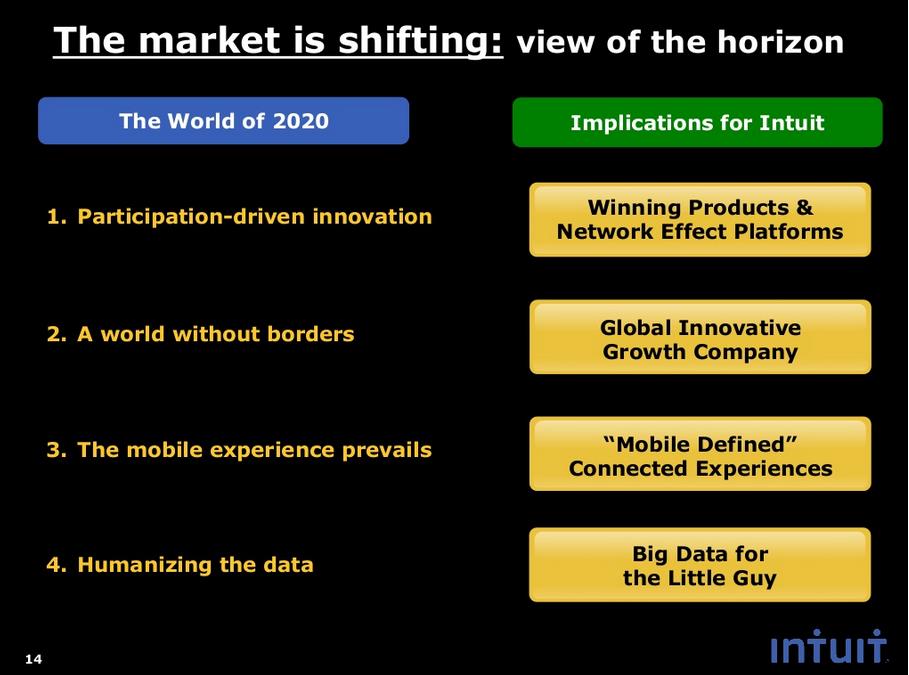
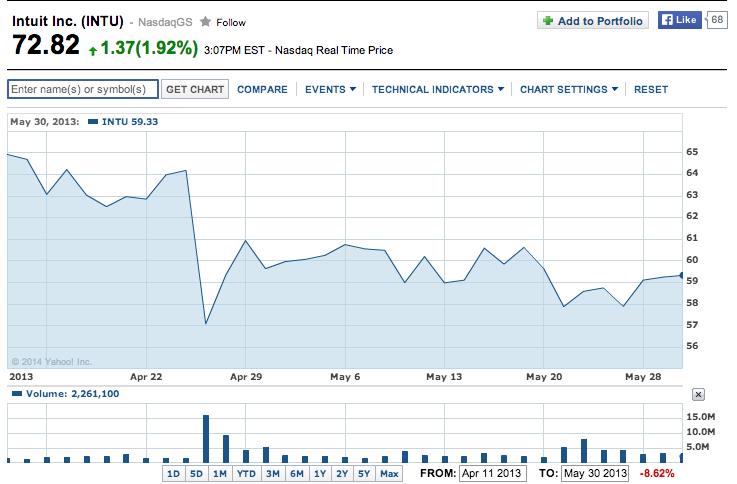
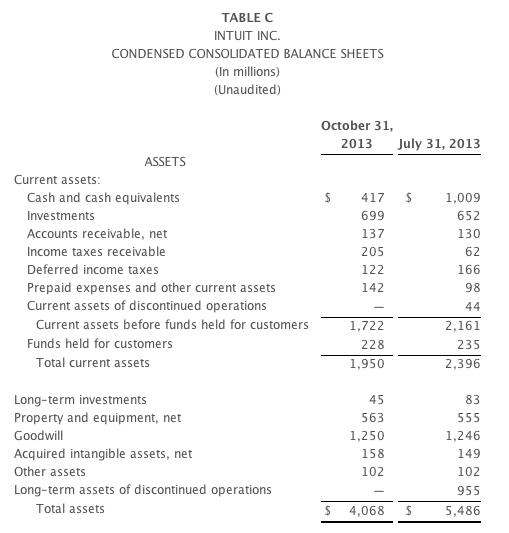
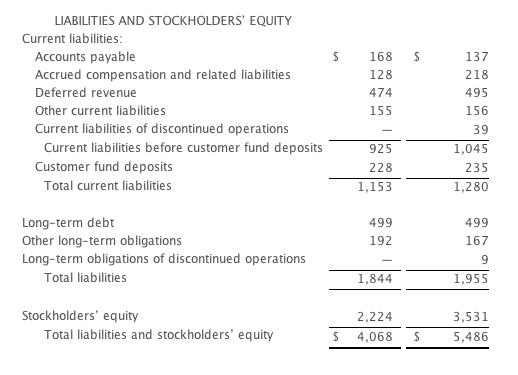
 Why Rivian Stock Surged Today
Why Rivian Stock Surged Today
